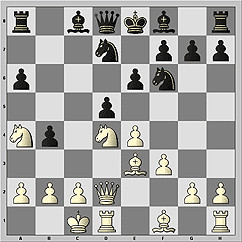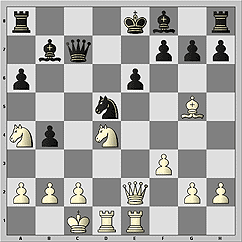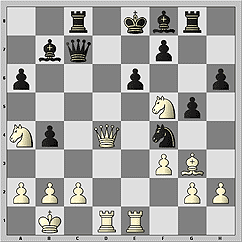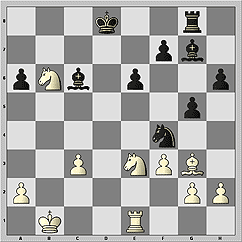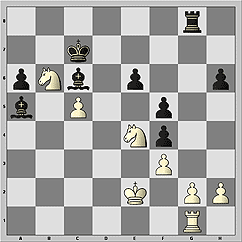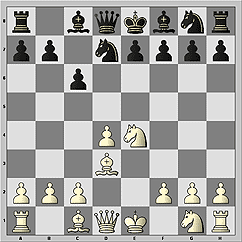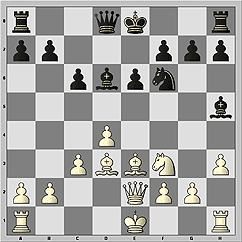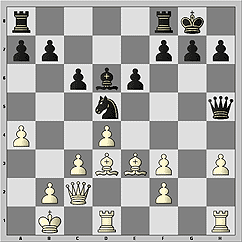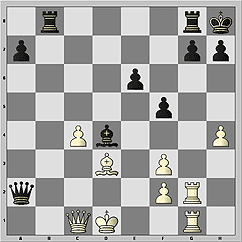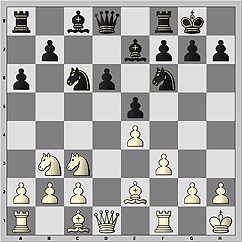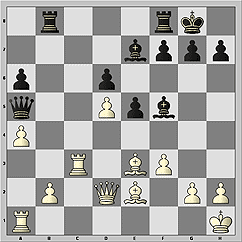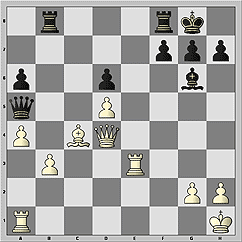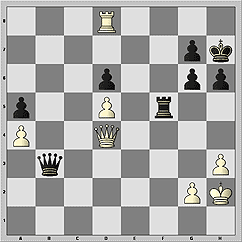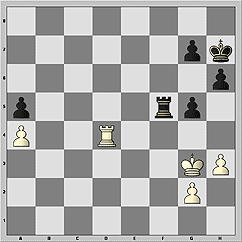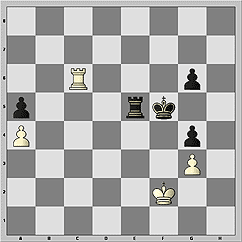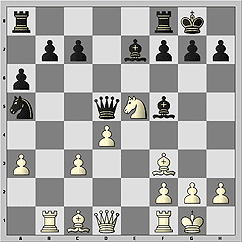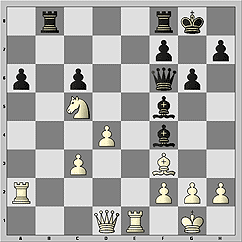 | Последние турниры |
Чемпионат России
СуперФинал

02.12.2006
Суперфинал чемпионата России проходит в Москве, в ЦДШ им. М.М.Ботвинника со 2 по 15 декабря при 12 участниках по круговой системе.
Крамник - Fritz

25.11.2006
С 25 ноября по 5 декабря в Бонне чемпион мира Владимир Крамник сыграет матч из 6 партий с программой Deep Fritz. В случае победы Крамник получит 1 миллион долларов, тем самым удвоив свой стартовый гонорар ($500000).
Мемориал Таля

5.11.2006
В Москве с 5 по 19 ноября проходил Мемориал Таля, в программе которого супертурнир 20-й категории и выдающийся по составу блицтурнир. Призовой фонд каждого состязания - 100.000 долларов.
Топалов - Крамник

23.09.2006
После того как "основное время" не выявило победителя (счет 6:6), 13 октября соперники сыграли 4 дополнительных поединка с укороченным контролем времени.
Томск. Высшая лига

2.09.2006
Со 2 по 11 сентября Томск принимает Высшую лигу чемпионата России 2006 года. В турнире участвуют 58 шахматистов - как получившие персональные приглашения, так и победившие в отборочных состязаниях.
Майнц

17.08.2006
В последние годы фестиваль в Майнце вслед за "Амбер-турниром" стал центром легких шахматных жанров. Наряду с массовыми ристалищами традиционно проходят чемпионские дуэли.
Россия - Китай

10.08.2006
С 10 по 20 августа в Китае проходит товарищеский матч сборных России и Китая. В нынешнем поединке как мужчины, так и женщины соревнуются на пяти досках по шевенингенской системе в два круга.
Все материалы
ChessPro

|
|

|
|
 |
By grandmaster
Sergey SHIPOV |
1.e2-e4 and White loses! |
My congratulations to all chess fans with a new grandiose event! The tournament in Argentina will determine the most legitimate World Champion for the last several years.
There are many excellent GMs who could have joined the battle for the title. I would suggest the following eight: Kasparov, Kramnik, Shirov, Ivanchuk, Ponomariov, Gelfand, Bacrot and Akopian. I don’t think that this squad is really inferior to that in San Luis. However it is impossible to embrace the boundless. Suppose these two “teams” put together play two big rounds. Apart from participants’ fatigue there will be another problem – other discontented GMs, such as Grischuk, Radjabov, Kamsky, Lautier, Van Wely, etc. It is a real vicious circle.
Personally, I support FIDE decision to resolve the crisis in a good old tried-and-true way. Let’s recall the match-tournament Hague-Moscow (1948) organized after Alekhine demise. Only five GM took part in the event, whereas several strong players such as Fine, Najdorf, Boleslavsky, Bronstein, were left overboard. Despite this drawback nobody questioned the legitimacy of Botvinnik’s title. Mikhail Moiseevich convincingly proved that he was not an accidental newcomer on chess Olympus but a great champion.
Two out of second eight that I mentioned, Kasparov and Kramnik simply refused to fight for the title; others did not score enough two-year aggregative rating. One way or another, the number of participants had to be limited. It is hardly possible to figure out any criteria which is better than rating in this situation.
First round lived up to chess fans’ expectations. The participants started right off the bat! It turned out though that some entrants were not prepared to hit the ground running. Probably high tension and enormous pressure took their tall. After all, you don’t play in the world championship every day! The first round games were ridden with, let’s put it this way, surprising moves. That is a well-known phenomenon when players react on the pressure with jerky, aggressive moves.
There is a well-known expression “1.e2-e4! and White wins”. All the first round games were opened with the king pawn move. However, only Black won! Actually, Black could have achieved even more. Let’s check out the games.
Right after the opening moves Black crossed the line of tolerated risk, but White failed to punish his opponent. One may say that Topalov had a champion’s luck!
Sicilian Defense B90
Peter LEKO (HUN) – Veselin TOPALOV (BUL)
1.e4 c5 2.Nf3 d6 3.d4 cxd4 4.Nxd4 Nf6 5.Nc3 a6 6.f3 e6. The Bulgarian keeps gathering the harvest on this field well-fertilized with a diligent home preparation.
7.Be3 b5.
8.Qd2! Topalov’s trademarked variation starts with 8.g4 h6 9.Qd2 b4 10.Na4 Nbd7! – Black leaves the b4-pawn unprotected. I think everyone remember his memorable victory over Kramnik in Wijk aan Zee 2005: 11.0–0–0 Ne5 12.Qxb4 Bd7 13.Nb3 Rb8 14.Qa3? Nxf3 15.h3 Nxe4 16.Be2 Ne5 17.Rhe1 Qc7 18.Bd4 Nc6 19.Bc3 d5 20.Nbc5 Qa7 and White resigned.
8...b4. Formerly the line 8...Nbd7 9.g4 Nb6 was regarded comfortable for Black. However, the latest games prove that Black has some problems if White dismisses the plan with castling long – 10.a4!
9.Na4! Recently Topalov scored another victory over the Russian GM in the capital of Bulgaria: 9.Nce2 e5 10.Nb3 Nc6 11.c4 Be7 12.Ng3 g6 13.Bd3 Nd7 14.Rd1 0–0 15.Qf2 a5 16.0–0 a4 17.Nc1 Nc5 18.Bb1 Qc7 19.Nce2 Be6 20.Bh6 Rfe8 21.Nf5 Bxc4 22.Ne3 Ba6 23.f4 exf4 24.Bxf4 Ne5! and Black prevailed in these complications (Kramnik – Topalov, Sofia 2005).
9...Nbd7 Veselin is moving in the tideway of his favorite line. However, g2-g4 and h7-h6 are not played yet. This subtlety favors White. It looks like transition to the French pawn structure is no good for Black: 9...d5 10.e5 Nfd7 11.f4 Qc7 12.Bd3 Nc5 13.Nxc5 Bxc5 14.Qf2 Qb6 15.0–0 Nc6 16.c3 0–0 17.Rae1 – White is clearly better (Fluvia – Ermenkov, Badalona 2005).
10.0–0–0 d5. Black is opening the center in the situation when White’s e-pawn cant advance to e5.
Chess classics would have been shocked had they see Black play. Indeed, Black lags in development, his king is still in the center, whereas White is fully prepared for the assault.
11.exd5! This excellent novelty is in full compliance with basic chess principles. Quickness and determination when it comes to an Upper hand in development. In the game of two Asian youngsters White opted for an inferior 11.Bf4 Bb7 and after 12.e5 Nh5 13.b3 Nxf4 14.Qxf4 Nc5 15.Nxc5 Bxc5 16.Qd2 Qb6 17.Kb1 Black emerged clearly better, although games was drawn (Teo Wei Xing – K. Wee, Singpore 2004).
11...Nxd5 12.Bc4. White is playing simply and powerfully. Leko is developing pieces aiming at the e6-pawn which is the last cover for the black king.
12...N7f6. The move 12...Bb7 should be analyzed. Apparently Veselin tried to fortify the e6-square as much as possible.
13.Bg5 Qc7. White was threatening with a blow on d5. The continuation 13...Bb7 14.Rhe1 Be7 fails to 15.Nf5! 0–0 16.Bxd5 Bxd5 17.Nxe7+ Qxe7 18.Nb6 Rad8 19.Nxd5 Rxd5 20.Qxd5+–.
14.Bxd5. The option 14.Qe2!? Bd6! also deserves attention. To prevent Black from completing development White has to deliver 15.Nxe6 (inferior is 15.Nf5 Bf4+ 16.Kb1 Bxg5 17.Bxd5 Rb8!) 15...Bxe6 16.Bxf6 (obviously not 16.Bxd5? Nxd5 17.Rxd5 0–0 -/+) 16...Nxf6 17.Bxe6 Bf4+ (after 17...0–0 18.Bb3 Bxh2 19.Kb1 White is slightly better) 18.Kb1 fxe6 19.Qxe6+ Kf8 and at this point with 20.g3 Black is forced to move his bishop to h6. White has a good compensation for the piece. Have a look at the h8-rook, for example...
14...Nxd5 15.Rhe1 (White’s artillery is deployed; Leko is threatening with shooting down the black king) 15...Bb7 16.Qe2!
How to protect the e6-pawn?
16...Qd6. The only move. It is clear now, that Topalov’s opening experiment failed. Actually is not even about equalized-did-not-equalized. Black found himself under a crushing attack!
17.Kb1. Leko’s solid, positional style as is. Since the opponent can’t complete development, the Hungarian decided to make a prophylaxis move. A simple 17.f4! with the idea of f4-f5 also looks good. Obviously 17...Nxf4 is impossible – 18.Qg4 Nd5 19.Nxe6, etc.
17...h6 (I think 17...g6 with the idea of bringing the bishop to g7 was a more solid move) 18.Bh4 Nf4. Amazing composure! Veselin withstand the pressure of all White’s army with two pieces.
19.Qf2 Qc7. That is the most important, critical moment of the game! Peter should have recalled the advice of Dr. Tarrasch, who did not like knights on the edge of the board…
20.Nf5. It turned out that this move was no more than a shot in the air. The knight transfer from a4 to b6 could have brought victory – 20.Nb6! Rb8 (20...Qxb6 21.Nxe6 Qxe6 22.Qa7!!) 21.Nf5 Bc6 (otherwise, the white rook rolls to d7) 22.Qd4 Rg8 (22...Ng6 23.Bg3 Qxb6 24.Qxb6 Rxb6 25.Bc7+–) 23.Nc4 (now White’s knight have the d6-square at their disposal) 23...g5 24.Bg3 Rd8 25.Ncd6+ Bxd6 26.Nxd6+ Rxd6 (26...Kf8 27.Bxf4 gxf4 28.Rxe6! is even worse for Black) 27.Qxd6 Qxd6 28.Rxd6 Bb5 – this ending with an extra exchange is far and away winning for White.
20...g5 21.Bg3 Rc8 (how should White proceed? – he can't bring his knight into play through b6 in view of Bf8-c5) 22.Qd4. Probably White should have doubled the rooks with 22.Rd2! Even in this position the success Black’s campaign is under question. For example 22...Rd8 (what else?) 23.Bxf4 gxf4 24.Rxd8+ Qxd8 25.Nc5!
22...Rg8. Naturally, the c2-pawn is taboo.
23.c3? (the only explanation of this poor move is White’s time scramble. He should have returned the queen to f2) 23...Rd8! (Black is forcing a very important rook exchange) 24.Qxd8+ (after 24.Qe3 Bc6! Tarrasch’s knigh gets into a real mess) 24...Qxd8 25.Rxd8+ Kxd8 26.Ne3 Bc6 27.Nb6 bxc3 28.bxc3 Bg7.
Just five moves down the road the positional dramatically changed. Instead of White’s dangerous attack we see an endgame in which Black has overwhelming advantage. White’s time scrambler hastened his defeat, but I doubt that even the best defense would have helped in such a position.
29.Bxf4 gxf4 30.Nd1 Bb5 31.a4 Bd3+ 32.Kc1 Kc7 33.a5 Bh8 34.Kd2 Bb5 35.Rg1 Bc6 36.Ke2 Be5 (Black’s bishops are tearing White’s defense to pieces) 37.c4 Bd4 38.Nf2 Bc3 39.Ne4 Bxa5 40.c5 f5.
White resigns.
Judit was wrong to pull the tiger by whiskers. He got angry!
Caro-Kann Defense B17
Judit POLGAR (HUN) – Vishwanathan ANAND (IND)
1.e4 c6 2.d4 d5 3.Nc3 dxe4 4.Nxe4 Nd7 5.Bd3
This contunuation used to be one of the most popular. Times changed. The continuation authoured by Igor Zaitsev 5.Ng5 Ngf6 (5...h6? 6.Ne6!) 6.Bd3 e6 7.N1f3 Bd6 (7...h6? 8.Nxe6!) 8.Qe2, etc. is the main line nowadays.
5...Ngf6 6.Nf3 (White could have taken the thoroughfare with 6.Ng5) 6...Nxe4 7.Bxe4 Nf6 8.Bd3 Bg4. Black managed to solve the problem of developing his passive light-squared bishop.
9.Be3 e6 (it is time to lock the gate) 10.c3 Bd6 11.h3 Bh5 12.Qe2. Judit is waiting. If Black castles short, White will have a clear plan of kingside attack.
12...Qa5! This innovation makes sense. Anand has prevented White from castling long. Black is waiting too! He is going to castle the same wing as White does. The game Frajt. – Vacek, Slovakia 2002 saw: 12...Nd5 13.g4 Bg6 14.0–0–0 Nf4 15.Bxf4 Bxf4+ 16.Kb1 Bxd3+ 17.Rxd3 Qd5 18.Rdd1 b5 19.Rhe1 a5 20.Qe4 Qxe4+ 21.Rxe4 Bc7 and Black did a good job losing this roughly equal endgame.
13.a4 (one may think that this venturesome thrust rules out White’s castling short…) 13...0–0. It is hard for me to tell why Judit decided to play in risky attacking manner. OK, it is her style, but given her high class she should have realized how dangerous was this approach for White. Apparently, she was too ambitions that day…
14.Qc2?! (White should have chosen between 14.0–0 and 14.g4) 14...Bxf3 15.gxf3 Qh5 The black queen is not only protecting her king, but also attacking White’s weak pawns.
16.0–0–0 (White has no choice) 16...Nd5 17.Kb1.
Judit’s attack might have been rewarded had her a-pawn been on a2 instead of a4. Alas, pawns can’t move backwards.
17...b5! (of course! Black uses the a4-pawn to launch his own attack) 18.Rdg1 f6 That is an interesting way to repel the threat Rg1–g5. On the other hand, this pawn won’t linger on f6 for too long.
19.axb5 cxb5 20.Bc1. After 20.Bxb5? Nxe3 White loses a piece; I think immediate doubling the rooks with 20.Rg4!? makes sense.
20...Rab8 (the canon is loaded. The b5-pawn is a cannon-ball that should hit the b3-square) 21.Qe2 Rfe8 22.Qe4 Kh8. A cunning move by Black. Vishy is flurting a little bit, pretending that he is not going to advance his pawn to f5.
23.h4 (in case of 23.Qg4 does not have to straighten out White’s pawn structure – 23...Qf7!) 23...f5 White’s light-squared bishop is caged.
24.Qe2 Qf7! Now Black can transfer his queen to the opposite wing and bring her into attack. The point is that White has no resources to create real threats at the kingside.
25.Rg2 (better was 25.Rg5!) 25...Bf4. Both opponents missed a blow 25...e5! It looks like Black is winning. Indeed, after 26.dxe5 Bxe5 he inevitably sacrifices a piece on с3, with a smashing attack. For example 27.Qc2 Rec8 28.Re1 (28.Bd2 Nb4) 28...Bxc3 29.bxc3 Nxc3+ 30.Ka1 Rb6 and it is all over for White.
26.Rhg1 Rg8 27.Be3 Qd7 28.Qd2 Bd6
29.Bc2 (White’s attack is at dead-set. There is nothing to undertake) 29...Qb7 (29...b4 30.c4 b3 31.cxd5 exd5) 30.Bg5?! Running out of time Judit made this final blunder in a tough position. White could have resisted with 30.Qd3. For example 30...b4 31.c4 b3 32.Bd1 but Black should win this position anyway. One of attracting options is 32...Qb4! 33.cxd5 Qa4 with a devastating attack.
30...b4 31.c4 b3 32.Bd3 Bb4 33.Qe2 (33.Qd1 Qa6 34.Qxb3 Bc3–+) 33...Qa6! 34.Bh6.
34...Nc3+! (one should not be Anand to deliver this final attack) 35.bxc3 Bxc3 36.Kc1 Qa3+. Black could have made it shorter 36...b2+ 37.Kc2 Qa2 38.Rb1 Qb3#!
37.Kd1 Qa1+ 38.Bc1 b2 39.Qe3 (39.Qc2 b1Q!) 39...Bxd4 40.Qd2 bxc1Q+ 41.Qxc1 Qa2
The time scrambler is over. White resigns.
The course of this game was disrupted in the time scramble. Instead of building up pressure White darted into hand-to-hand fight and nearly lost.
Sicilian Defense B92
Alexander MOROZEVICH (RUS) – Rustam KASIMDZHANOV (UZB)
1.e4 c5 2.Nf3 d6 3.d4 cxd4 4.Nxd4 Nf6 5.Nc3 a6 6.Be2 e5 7.Nb3 Be7 8.0–0 0–0 9.Kh1 Nc6 10.f3.
Virtually all GMs of Tomsk the winner of the Euro Club Team Championship play this variation. Kasimdzhanov must have checked good games by Yakovenko and Smirnov in this line. No doubt, Morozevich, as the team leader is fully aware of his teammate’s analysis. Actually, it is a very important resourse of preparation for a particular opponent. One should check not only the opponent’s games but also those by his friends and colleagues. They might have analyzed many positions together…
10...b5. The position emerging after 10...Be6 11.Nd5 a5 12.Be3 a4 13.Nc1 a3 14.b3 Bxd5 15.exd5 Nd4 16.c4 Nd7 occurred in the games (although move order was different) Jakovenko – Volzhin (Sochi 2005) and Smirnov – Vallejo (San Vincent 2005). The first saw Dmitry play 17.Nd3, in another Pavel opted for 17.Bd3 and both won! It looks like White is better here. With this in mind, Kasimdzhanov decision to deviate seem to be the right one.
11.Be3. Somewhere around this move the players got out of books. In the game Palac, M. – Sutovsky, E., Pula, 2000 White initiated too risky complications – 11.Nd5 Nxd5 12.exd5 Na5 13.Bd2 Nc4 14.Bxc4 bxc4 15.Na5 Bd7 16.b3 Bf6! 17.bxc4 e4 18.Rb1 e3 19.Bb4 Re8 20.Re1 Rb8 and pretty soon Black won.
11...Na5 (if 11...Be6 very strong – 12.Nd5) 12.Nxa5 Qxa5 13.Qd2 Qc7. White was threatening with a standard knight thrust on d5.
14.a4. White conducting the game in a solid positional manner. Morozevich is going to exploit the weakness of Black’s queenside pawns.
14...b4 15.Nd5. After 15.Nd1 Be6 the threat d6-d5 forces White to play 16.c4, but in this case Black has gets an excellent position with 16...a5 17.b3 Nd7. The knight will take an perfect position on c5.
15...Nxd5 16.exd5 Bf5. Here and several moves down the road Rustam has not advanced his pawn to a5. Probably he did not want to loosen the b5 square. However, on a6 his pawn will become a real weakness.
17.Rfc1 Qa5 18.c4 bxc3 19.Rxc3 Rab8.
20.Bc4. White could have trade pawns with a little combination: 20.b4!? Qxb4 (20...Rxb4?! 21.Rc4) 21.Bxa6 creating a dangerous remote passer. However, in this case Black strike up counterplay in the center with 21...e4! I think it is sufficient to maintain equilibrium.
20...Bf6 21.b3 e4 (in my opinion Black is in too much hurry to defuse the situation) 22.Bd4 Bxd4 23.Qxd4 exf3 (after 23...Rfe8 24.f4! White has an edge) 24.Rxf3 Bg6 25.Re3. White has an advantage due to the weakness of Black’s a6-pawn. No sooner the black queen leaves a5, White proceeds with a4-a5 fixing the target on a6. Theoretically, Black can sacrifice this target. The problem is that any endgame will be winning for White. His remote passer will reach the last rank.
25...Rfe8 26.h3 h6 27.Ra2 Rxe3 28.Qxe3 Ra8. Black has to make this awkward move. The white queen was threatening with penetration to a7.
29.Kh2 Kh7 (both opponents were short of time at this point; surprises were quick to come!) 30.Ra1. White could have obtained a sizable advantage with 30.Qe7! Qb4 31.a5.
30...Kg8 31.Qf4 Rd8 32.Qd4 (from practical standpoint White should have marked time – 32.Qe3) 32...Re8 33.Rf1?! Alexander went too far. Carried away by a fallacious attacking idea he let his opponent activate pieces and advance his a-pawn!
33...Qb4 34.Rf4 Re5 35.Qf2 (aiming at the f7-pawn) 35...a5! That is a cool reply by an experienced defender. The discovered attack at the black king is not innocuous.
36.Bd3 With all its flaws it is a consequential move. Otherwise White’s previous play makes no sense.
36...Qxb3 37.Bxg6 fxg6 38.Rf8+ Kh7. It turned out that “winning” move 39.Qf7 prepared by Morozevich is met with a simple refutation 39...Qxd5! and the checkmate on g8 is called off.
39.Rd8 Rf5 (Black must not allow the white queen to f8) 40.Qd4. At this point Rustam let the victory slip with the last move before the time control.
40...Qxd5 Black should have played 40...Rg5! first, threatening with checkmate in two and only after 41.Qd2 captured the pawn with 41...Qxd5. The point is that in such move order 42.Rxd6 fails to 42...Rxg2+! and Black transposes into a winning queen endgame.
41.Rxd6! Qxd4 (probably the queens on the board offered more practical chances – 41...Qb3!?) 42.Rxd4 g5 43.Kg3.
Although not without some problems White managed to hold this rook endgame. As this outcome seems logical, I omitted some subtleties.
43...h5 44.Rc4 Kh6 45.Rc6+ g6 46.Ra6 Rc5 47.Kh2 Kg7 48.g3 g4 49.hxg4 hxg4 50.Kg2 Re5 51.Kf2 Kf7 52.Ra7+ Kf6 53.Ra6+ Kf5 54.Rc6.
54...Re4. Draw.
There was no real fight in this encounter of two friends. Actually friendship has nothing to do with it. As we all know, friends are OK, when they don’t get in the way, especially at the World Championship! The reason is quite different. Black played for a very solid, bullet-proof opening, whereas Peter’s preparation was not sufficient to wrest some advantage.
Petroff Defese C42
Peter SVIDLER (RUS) – Michael ADAMS (ENG)
1.e4 e5 2.Nf3 Nf6 I am sure that Michael won’t entertain his opponents with opening surprises at this event. He has a good lucubrated repertoire which will be a solid basis for his middlegame play.
3.Nxe5 d6 4.Nf3 Nxe4 5.d4 d5 6.Bd3 Nc6 7.0–0 Be7 8.c4 Nb4 9.Be2 0–0 10.a3 Nc6 11.cxd5 Qxd5 12.Nc3 Nxc3 13.bxc3 Na5 14.Rb1 a6 15.Ne5 Bf5 16.Bf3.
16...Qe6. That is a novelty. It is hard to say how Peter was going to improve White’s play in the game Blehm – Urban (Koszalin 1998) which saw 16...Be4 17.Bxe4 Qxe4 18.Rb2 Qd5 19.Re2 Bd6 20.Rfe1 b5 21.Re4 Rae8 22.R4e3 f6 23.Ng4 Rxe3 24.Nxe3 Qb3 25.Qg4 Re8 26.Rf1 Qe6 27.Qd1, draw. The point is that it can be done on every move!
17.Rb2 (this pawn sacrifice is virtually forced as the rook had nowhere to retreat; 17.Ra1? Nb3) 17...Bxa3 18.Re2 Bxc1 19.Nc6. Almost all white pieces are under attack. However, it breath no life in the position. The result was just opposite – a drought and dead calm.
19...Qf6 20.Nxa5 Bf4 21.Nxb7 (White regains a pawn but his achievements end there) 21...Rab8 22.Rfe1 g6 23.Ra2 c6 24.Nc5.
The opponents signed a piece treaty. After 24...Rb1 25.Qe2 Rfb8! White has no time for capturing on a6 because of the threats along the fist rank. The draw by perpetual was a quite possible outcome – 26.Ra1 R1b2 27.Qxa6 Bxh2+ 28.Kxh2 Qh4+ 29.Kg1 Qxf2+ 30.Kh1 Qh4+ 31.Kg1 Qf2+ etc.
It would be better if the opponents had performed these moves over the board instead of leaving most of chess funs in bewilderment. On the other hand, it is their right…
There is no point in discussing the standings after the first round. I would like to note, that the main favorites, Anand and Topalov are determined to win and not inclined to be overcautious. Other participants are also eager to fight for the title. The tournament distance is long enough; the bad starters have a chance to catch up.
|
|


